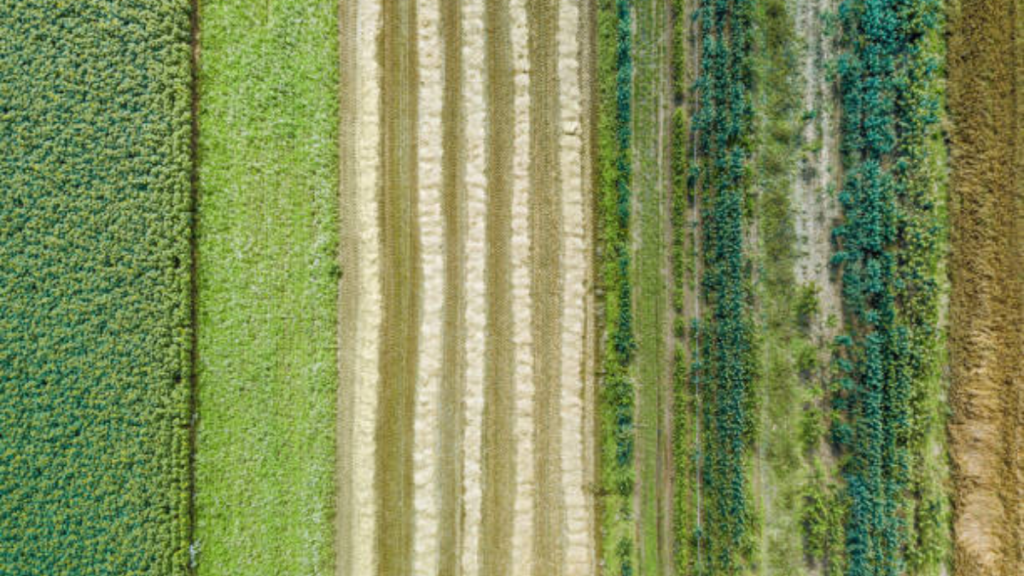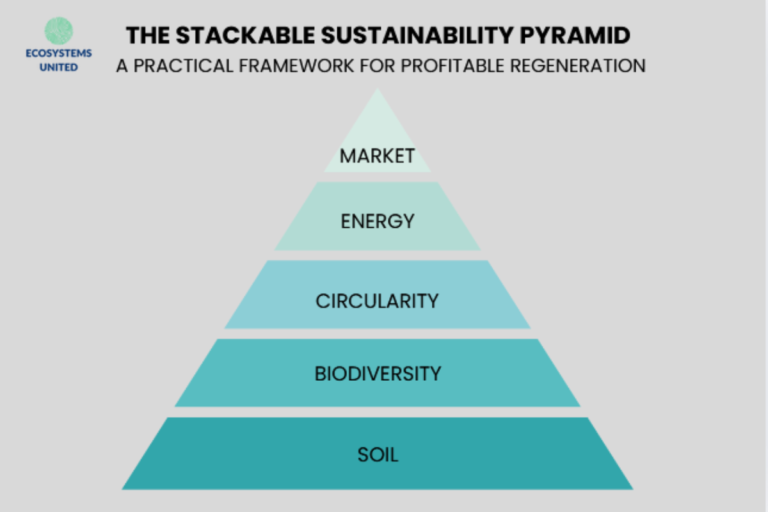intercropping vs polyculture: how multi-crop systems boost farm sustainability

This article clarifies the terminology and concepts behind different multi-crop systems, specifically examining intercropping vs polyculture.
Agricultural systems that grow multiple crops together have existed for millennia. Indigenous farming traditions worldwide have long recognized the benefits of cultivating diverse plants in proximity. As modern times demand that we seek more sustainable and resilient food production methods, these multi-crop approaches are receiving renewed attention from researchers, farmers, and food systems advocates.
Intercropping: Definition, Benefits, and Real-World Examples
What is intercropping?
Intercropping is the practice of growing two or more crops simultaneously in the same field, typically in a specific pattern such as alternate rows, strips, or mixed plantings.
What are the key characteristics of intercropping?
- Usually involves annual crops
- Plants are deliberately arranged in specific patterns
- Often focuses on complementary resource use (like tall sun-loving plants with shorter shade-tolerant ones)
- Traditionally practiced in many indigenous and smallholder farming systems worldwide
What are examples of intercropping?
- The “Three Sisters” of Native American agriculture: corn, beans, and squash
- Wheat and chickpeas grown in alternating rows
- Coffee plants intercropped with banana trees for shade
What are the benefits of intercropping?
- More efficient use of space, water, and nutrients
- Natural pest management through diversity
- Risk management (if one crop fails, others may survive)
- Potential yield advantages compared to monocultures
Polyculture Farming: How Modern Agriculture Is Embracing Ecosystem Diversity

What is polyculture?
Polyculture is a broader concept referring to the cultivation of multiple plant species in the same space, intentionally mimicking the diversity found in natural ecosystems.
What are the key characteristics of polyculture?
- Can include both annual and perennial plants
- May involve more complex compositions and layers than intercropping
- Often aims to create functional ecosystems, not just crop combinations
- Places greater emphasis on ecological relationships between components
What are the benefits of polyculture?
- Enhanced ecological resilience
- Improved soil health through diverse root structures and functions
- Expanded habitat for beneficial organisms
- Potential for greater sustainability over time
5 Types of Multi-Crop Farming Systems for Sustainable Agriculture

1. Annual Intercropping: Combining Crops for Maximum Yield and Resilience
Annual intercropping is the simplest form of polyculture, where multiple annual crops are grown together for one growing season.
2. Multi-Story Cultivation: Vertical Farming Approaches for Space Optimization
Multi-story cultivation systems utilize vertical space by combining plants of different heights, creating multiple “stories” of crop production.
Examples of multi-story cultivation include:
- Traditional home gardens in tropical regions
- Food forests with tall trees, fruit shrubs, and ground crops
- Rice paddies with fish farming beneath (aquatic layer)
3. Perennial Polycultures: Long-Term Farming Systems That Build Soil Health
Perennial polyculture systems are composed primarily of perennial plants (those that live for multiple years) grown together in beneficial arrangements.
Examples of perennial polycultures include:
- Perennial grain fields mixed with nitrogen-fixing legumes
- Meadow orchards with fruit trees and perennial herbs
- Prairie-inspired agricultural systems with multiple native perennial species
Distinctive features of perennial polycultures are:
- Minimal soil disturbance once established
- Deep, extensive root systems that build soil health over time
- Reduced need for replanting
- Enhanced carbon sequestration potential
4. Cover Cropping Systems: Protecting Soil While Boosting Productivity
Cover cropping systems involve planting non-cash crops during off-seasons or alongside primary crops to improve soil health and provide ecological services.
Examples of cover cropping systems include:
- Winter rye planted after corn harvest
- Clover understory in orchards
- Living mulches between vegetable rows
5. Agroforestry: Integrating Trees Into Productive Agricultural Landscapes
Agroforestry intentionally combine trees with crop production and/or livestock.
Types of agroforestry include:
- Silvopasture: Trees + livestock grazing
- Alley cropping: Rows of trees with crops between
- Forest farming: Cultivation of crops under a forest canopy
- Windbreaks: Trees protecting crops from wind damage
- Riparian buffers: Trees along waterways on farm land

Intercropping vs Polyculture: Key Differences That Every Farmer Should Know
While all intercropping is a form of polyculture, not all polycultures are intercropping. The key distinctions include:
| Aspect | Intercropping | Broader Polyculture |
|---|---|---|
| Timeframe | Usually single season | Often includes perennials |
| Complexity | Typically 2-3 species | Can involve dozens of species |
| Arrangement | Often regular patterns | May mimic natural ecosystems |
| Primary Goal | Crop yield optimization | Ecological functionality plus yields |
| Management | Often mechanized | May require more observation-based management |
Benefits of Multi-Crop Farming Systems: From Soil Health to Climate Resilience
While specific advantages vary, multi-crop systems generally offer:
- Biological diversity: Creating habitat for beneficial insects, soil microorganisms, and wildlife
- Resource efficiency: More complete use of available sunlight, water, and nutrients
- Risk management: Spreading risk across multiple crops with different vulnerabilities
- Ecological services: Improving pollination, pest control, and soil health
- Climate resilience: Better at withstanding extreme weather events
Overcoming Challenges: Implementing Diverse Crop Systems in Modern Agriculture
These diversified approaches aren’t without challenges:
- Knowledge requirements: Successful implementation demands an understanding of plant interactions
- Management complexity: More variables to monitor and manage compared to monocultures
- Mechanization limitations: Standard farm equipment is often designed for monocultures
- Market access: Conventional supply chains may not accommodate diverse or unusual crops
- Transition periods: Converting from conventional systems may involve temporary yield reductions
How to Choose the Right Multi-Crop System for Your Farm or Garden
The best multi-crop system depends on numerous factors:
- Climate and growing conditions
- Available land and resources
- Farmer knowledge and preferences
- Market opportunities
- Long-term goals (production, conservation, resilience)
Many successful farmers blend elements from different approaches, creating hybrid systems tailored to their specific context and goals.
Intecropping vs Polyculture: An Outlook
The distinction between intercropping and polyculture represents more than just terminology—it reflects different approaches to agricultural diversity, from simple companion planting to complex ecosystem mimicry. These approaches exist along a spectrum, with increasing complexity, ecological functionality, and potential sustainability benefits.
As agriculture faces mounting challenges from climate change, biodiversity loss, and resource constraints, these diverse cropping systems offer promising alternatives to conventional monoculture. Whether through the relative simplicity of intercropping or the ecosystem-based approach of complex polycultures, the principle remains the same: diversity in agricultural systems, thoughtfully managed, can create more resilient, productive, and sustainable food production.
Ready to diversify your farming system?
Multi-crop systems like intercropping and polycultures aren’t just buzzwords—they’re pathways to more resilient, profitable, and climate-smart agriculture. Whether you’re just starting or looking to refine your current practices, understanding the right combinations for your farm is key.
If this article helped you understand intercropping vs polyculture, share it with your fellow growers and agri-curious friends.
Subscribe to Ecosystems United for weekly insights into sustainable farming, practical tools, and real-world case studies.
We’d love to hear from you: What multi-crop combinations are you trying (or planning to try) on your farm or in your garden this year?
References:
- Sustainable Agriculture Network. (n.d.). The importance of crop rotation and polyculture in sustainable farming. Sustainable Agriculture Network. https://www.sustainableagriculture.eco/post/the-importance-of-crop-rotation-and-polyculture-in-sustainable-farming
- Rani, M., & Megha Latha, K. (2023). Crop rotation and polyculture strategies. In Integrated Pest Management (Chapter 8). https://www.researchgate.net/publication/384056405_Chapter_-_8_Crop_Rotation_and_Polyculture_Strategies
- Iverson, A. L., Marín, L. E., Ennis, K. K., Gonthier, D. J., Connor-Barrie, B. T., Remfert, J. L., Cardinale, B. J., & Perfecto, I. (2014). Do polycultures promote win-wins or trade-offs in agricultural ecosystem services? A meta-analysis. Journal of Applied Ecology, 51(6), 1593–1602. https://besjournals.onlinelibrary.wiley.com/doi/10.1111/1365-2664.12334



One Comment